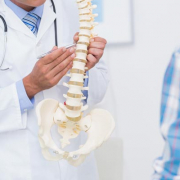Can leg length discrepancy cause or worsen scoliosis?
Leg length discrepancy (LLD) is a common orthopaedic condition among children and adults, with a prevalence of 90% in the general population and 40% among athletes. LLD occurs when the lower limbs are of unequal length; the discrepancy is typically less than 10 mm and asymptomatic.
Individuals easily compensate for it through small adaptations of which they are very often unaware (such as bending or extending one leg more than the other). Some children are born with LLD; in other cases, the condition is acquired due to causes such as tumours, radiation, infections or injuries.
LLD can be classified as functional or structural depending on the aetiology, i.e., the underlying cause.
Functional LLD refers to an apparent asymmetry, in the absence of real shortening or elongation of the osseous components of the lower limb. It is typically a result of pelvic obliquity related to adaptive soft-tissue shortening, joint or muscle contractures, ligamentous laxity, or axial misalignment. As the pelvis rotates, the legs are pulled into apparent different lengths.
Structural LLD, on the other hand, is a primary disorder causing actual physical shortening or lengthening of a limb, with the osseous change occurring between the ilium and the foot. The causes of shortening are more common than those of lengthening, and they may be congenital or acquired: shortening is most often due to fractures along the physis (Salter-Harris fractures), which can stop bone growth and lead to LLD.
LLD can be associated with several musculoskeletal disorders, including scoliosis and resultant degenerative spinal changes. However, the degree of LLD required to cause such disorders is still debated. LLD has been shown to cause pelvic obliquity in the frontal plane. In order to maintain shoulder balance and compensate for the pelvic obliquity, the condition that most frequently occurs is lumbar scoliosis with convexity directed towards the shorter limb. Scoliosis caused by LLD is not true scoliosis.
Should scoliosis due to LLD be treated?
This type of scoliosis, termed functional scoliosis, is non-progressive and involves a structurally normal spine with an apparent lateral curvature: it is evident in the erect position, but reduced when the subject is seated, supine or prone. The greater the degree of LLD, the more apparent the functional scoliosis may be.
This type of scoliosis regresses fully or partially when its cause (i.e., the LLD) is removed.
A simple remedy is to use shoe lifts, which may be internal or external depending on the degree of LLD.
If, after clinical evaluation, the functional scoliosis is found to be reducible (in part or totally) with a shoe lift, this solution will also be useful for reducing the overloading of the spinal joints and for reducing the structural and disc changes that occur over the years in the presence of scoliosis due to LLD (particularly when the difference between the two limbs is greater than 9 mm), as various studies have shown.
In a patient with structural and functional (LDD-related) scoliosis, it is appropriate to carry out tests to evaluate the usefulness or otherwise of a shoe lift. A shoe lift does not treat true scoliosis and the decision on whether or not to use it is a complex and individual one that should be made by the specialist.
Applebaum A, Nessim A, Cho W. Overview and spinal implications of leg length discrepancy: narrative review. Clin Orthop Surg. 2021;13(2):127-34.
Giles LG, Taylor JR. Lumbar spine structural changes associated with leg length inequality. Spine (Phila Pa 1976). 1982;7(2):159-62.
Adams MA, Hutton WC. The effect of posture on the role of the apophyseal joints in resisting intervertebral compressive forces. J Bone Joint Surg Br. 1980;62(3):358-62.
Murray KJ, Azari MF. Leg length discrepancy and osteoarthritis in the knee, hip and lumbar spine. J Can Chiropr Assoc. 2015;59(3):226-37.









